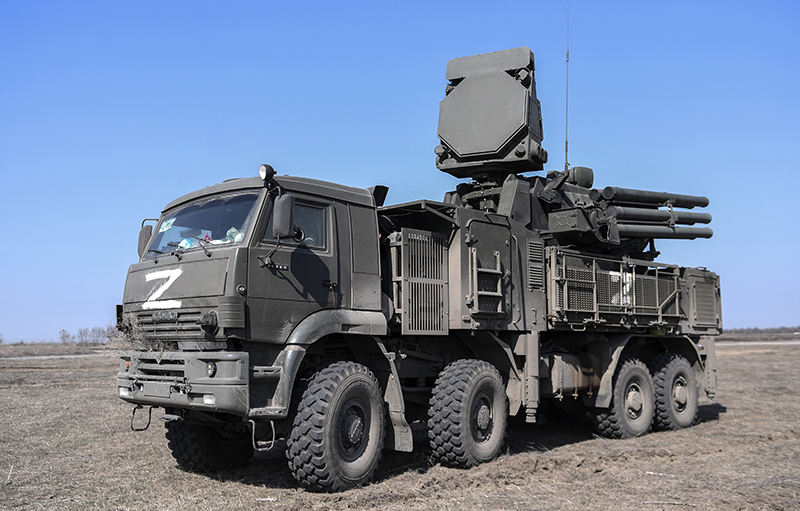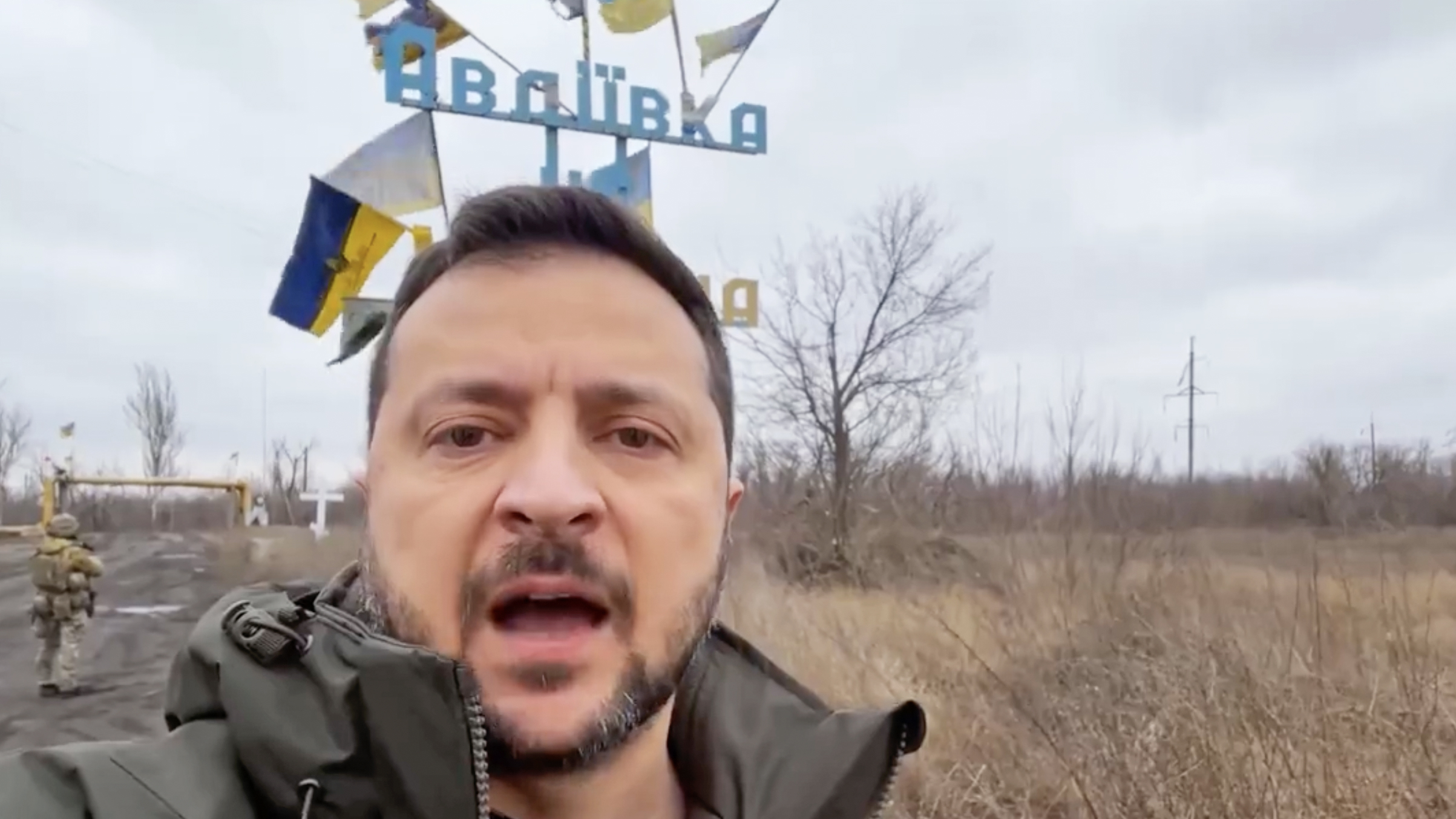As Russia launched the heaviest wave of missile and drone strikes against Ukraine since the start of the full-scale invasion, Ukrainian President Volodymyr Zelensky appears to have visited very close to the front lines.
While the date of the visit hasn’t been disclosed, Zelensky said on X today that he had visited Ukrainian troops near Avdiivka, the eastern Ukrainian town that has seen very heavy fighting in the last few months.
Zelensky wrote: “I visited the positions of the 110th ‘Marko Bezruchko’ Mechanized Brigade. One of the toughest spots of the front line. I personally thanked the warriors. We reviewed the defense situation and our troops’ key needs with the commander. I honored the best servicemen with state decorations and presented Junior Sergeant Ihor Tymoshchuk with the Gold Star of the Hero of Ukraine. I thanked everyone on the front lines for their service this year. Our whole country withstood it thanks to such warriors. All those who, against all odds, defend our country. Those who deliver combat results every day.”
Understandably, Zelensky didn’t provide a detailed location of his visit, although open-source intelligence based on the video he published appears to indicate that the Ukrainian leader was only a couple kilometers from some of the heaviest fighting anywhere in the country.
Before diving into more developments from the conflict in Ukraine, The War Zone readers can review our previous rolling coverage.
The Latest
According to the U.S.-based think tank the Institute for the Study of War (ISW), the Russian employment of penal battalions in its war in Ukraine has now extended to using Ukrainian prisoners of war (PoWs). As the ISW points out, such a policy is in breach of the Geneva Convention on PoWs.
With Russia having “extreme difficulty” in filling the ranks of its combat infantry, according to an October analysis from the U.K. Ministry of Defense, the Kremlin has been relying heavily upon convicts, within so-called Shtorm-Z penal units.
“These company-sized groups were likely first fielded in 2022. There is a realistic possibility that Russia originally envisioned them as relatively elite organizations which could seize the tactical initiative,” the U.K. Ministry of Defense posted on X.
First-person view (FPV) drones continue to provide some of the most dramatic combat footage from the war.
In this recent example, an apparently civilian car with a member of the Russian military or pro-Russian separatist at the wheel attempts to escape the attention of a Ukrainian FPV drone. In the process, the car overturns before being destroyed by the drone.
Here, the results of another Ukrainian FPV drone strike are seen on a Russian military UAZ-452 series ‘Bukhanka’ van. In this case, the occupants are said to have survived.
It’s also interesting to see how FPV operators train to use their drones. In this example, from Russia, the drone operators are tasked with ‘attacking’ a suspended balloon target. The drone is subsequently captured in a net for reuse.
More Ukrainian FPV footage now, with some very clear footage showing the successful engagement of a Russian T-72 tank, reportedly in the Donetsk region. The drone can be seen entering the tank via a turret hatch, leading to a colossal detonation as the ammunition cooks off, and a ‘turret toss.’
Notably, the tank is fitted with a ‘cope cage’ protective screen, above the turret, intended to deflect drone-dropped mortars as well as drone attacks from above. In this instance, the accuracy of the FPV drone delivery renders the cope cage useless.
Another remarkable turret toss is seen in the next video, which features the destruction of a Ukrainian BTR series 8×8 wheeled armored personnel carrier.
In what may be a response to recent losses of Russian tactical aircraft, it’s been announced that longer-range versions of the UMPK series of glide bomb kits are now in development.
Sergei Chemezov, the head of the Rostec state defense conglomerate, recently said that “work is underway on an improved version of the [UMPK] modules, which will significantly increase the range of use of aerial bombs.”
As we reported earlier this week, Ukrainian authorities have noted a significant reduction in Russian airstrikes, especially those involving glide bombs, after a spate of recent losses.
Though the various aircraft losses remain unconfirmed, The War Zone had previously highlighted evidence of a shift in focus and asset deployment on the part of Ukrainian air defenders and noted that it could lead to exactly this kind of disruption in Russian air operations.
Longer-range versions of the UMPK glide bombs may well be the Russian response to these changing realities.
North Korea has delivered millions of artillery shells to Russia, Bloomberg reports. Based on the assessment of South Korean intelligence agencies, Pyongyang has now stepped up its supply of these much-needed munitions, the first of which were apparently supplied in the Fall. Evidence for the scale of the deliveries comes from satellite imagery, showing the transport of arms shipments from North Korea into Russia.
One interesting infantry weapon that recently appeared in Ukraine — reportedly in the hands of a Swedish volunteer — is the FN Herstal FN40GL 40mm grenade launcher, in standalone form. This weapon began to be seen in early June, as Ukraine’s counteroffensive got underway, but this is one of the best views we have of it so far. Firing standard 40mm NATO grenade ammunition, the grenade launcher is also designed to be attached to FN Herstal SCAR series assault rifles.
Decoys of various kinds have proliferated on the battlefield since the start of Russia’s full-scale invasion, with some being far more faithful to the original than others.
Falling into the less convincing category is this Russian replica of the Pantsir-S1 air defense system. A photo of the original system is provided further a little below for the sake of comparison.

Ukrainian air defenses are showcased in the next video, recording the dramatic scenes in the night sky over the port city of Odesa last night. The video was recorded from the bridge of a Turkish ship and clearly shows tracer rounds from intense anti-aircraft fire put up as Russia launched an unprecedented wave of missile and drone attacks against targets across Ukraine.
Unconfirmed reports suggest that the Kremlin has punished the commanders of air defense forces after their failure to defeat a Ukrainian cruise missile attack that destroyed the Russian Navy’s Ropucha class landing ship Novocherkassk in the port city of Feodosia.
Supposedly, at least some commanders from Crimean air defense units have been transferred to assault groups, to take part in fighting on Ukraine front lines. Russia is also cracking down on potential intelligence collection on the peninsula that could aid in planning such attacks, raiding homes and seizing phones.
Local reports from Russian-occupied Crimea suggest that 74 sailors were killed during the attack on the ship Novocherkassk on December 26, and another 27 were injured.
Soviet-era Ukrainian air defense equipment is less commonly seen in action nowadays. That makes the following video, of a 9K33 Osa surface-to-air missile system air of the 1129th Anti-Aircraft Missile Regiment all the more interesting.
As we have described in the past, the Osa, known to NATO as the SA-8 Gecko, is a short-range air defense system (SHORADS) based on a fully amphibious six-wheeled BAZ-5937 transport vehicle. A variety of 9M33 series missiles are available for the Osa, the original variant having a range of 7.5 miles all of which use radio command guidance. The number of these systems that were available to Ukraine before the start of hostilities is unclear.
There have been countless videos showing both Russian and Ukrainian helicopters, as well as fixed-wing attack aircraft, ‘lobbing’ unguided rockets to avoid the worst of local ground-based air defenses.
Now we also have cockpit footage of the latest Mi-28NM version of the Havoc attack helicopter employing the same tactics, to launch 80mm rockets.
The Mi-28NM was previously best associated with a far more capable weapon, the new-generation LMUR missile. The missile’s long range provides another way of engaging targets from outside the engagement envelope of ground-based air defense systems.
More imagery has emerged of the U.S.-supplied Stryker 8×8 wheeled armored fighting vehicle in Ukrainian service. What appeared to be the first combat-related video of a Stryker in Ukraine appeared on social media in August 2023.
You can read more about the particular capabilities Stryker provides to Ukraine in our story here.
Russian forces can be seen launching a desperate attack near Kupyansk, in the Kharkiv region, in the next video.
The tank leading the assault, fitted with a mine plow, is disabled by a mine, leaving the rest of the column stuck. Another tank and a BMP-2 infantry fighting vehicle are then destroyed. The final surviving BMP-2 is seen making a final charge, before it, too, is knocked out in the minefield. Ukrainian forces then deliver a coup de grace with cluster ammunition.
Among the latest ‘technicals’ to appear on the Ukrainian battlefield is this BMW saloon, adapted to fire artillery rockets — probably repurposed air-launched types — from its trunk. Whether ‘the ultimate driving machine’ also makes for the ultimate multiple rocket launcher remains unclear.
That’s it for now. We’ll update this story when there’s more news to report about Ukraine.
Contact the author: thomas@thedrive.com
